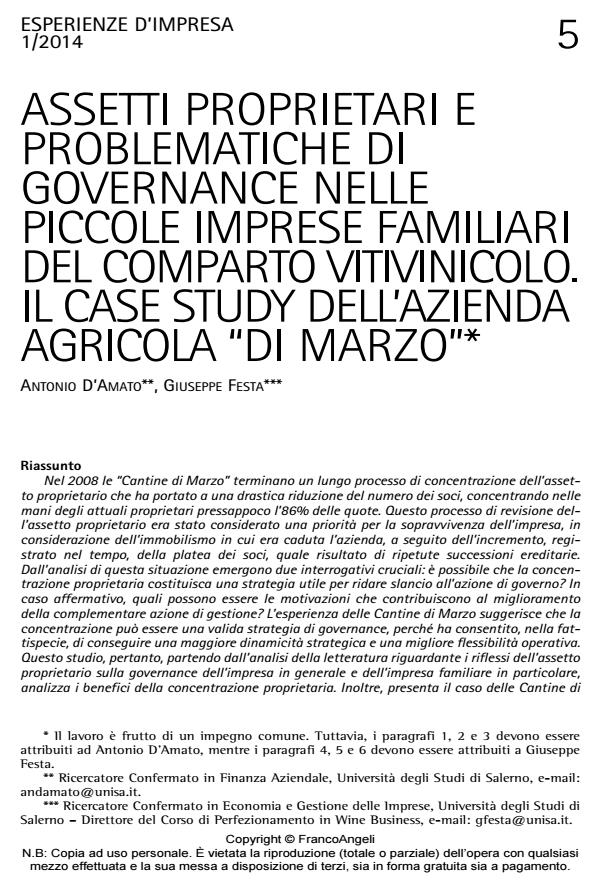Ownership structure and governance issues in small family wine business. The Case study "di marzo"
Journal title ESPERIENZE D'IMPRESA
Author/s Antonio D'Amato, Giuseppe Festa
Publishing Year 2014 Issue 2014/1
Language Italian Pages 23 P. 5-27 File size 144 KB
DOI 10.3280/EI2014-001001
DOI is like a bar code for intellectual property: to have more infomation
click here
Below, you can see the article first page
If you want to buy this article in PDF format, you can do it, following the instructions to buy download credits

FrancoAngeli is member of Publishers International Linking Association, Inc (PILA), a not-for-profit association which run the CrossRef service enabling links to and from online scholarly content.
In 2008, the "Cantine di Marzo" wine farm concluded a long process of proprietary concentration, which led to a drastic reduction of the number of shareholders, concentrating in the hands of the present owners about 86% of the shares. This process of revision of the ownership was considered a priority for the survival of the enterprise, in consideration of the immobility in which the company had fallen as a result of the increase of the shareholders, registered as a result of repeated inheritances. From the analysis of this situation two crucial questions emerge: is it possible that the ownership concentration constitutes a useful strategy to revive the action of the governance? If so, what are the reasons that contribute to the improvement of the complementary action of the management? The experience of the Cantine di Marzo wine farm suggests that the concentration may be a viable strategy of governance, since it enabled, in this case, to achieve a more strategic dynamics and a better operational flexibility. This study, therefore, starting with an analysis of the literature on the effects of the ownership structure on corporate governance of businesses in general and family businesses in particular, analyzes the benefits of ownership concentration. Furthermore, it presents the case study Cantine di Marzo, illustrates the results of the analysis and discusses the scientific and managerial implications.
Keywords: Corporate governance, wine farm, family business, stewardship theory, management performance.
- The effect of ownership concentration on non-financial information mandatory disclosure: Evidence from Italy Simona Fiandrino, Fabio Rizzato, Donatella Busso, Alain Devalle, in Corporate Ownership and Control /2019 pp.79
DOI: 10.22495/cocv17i1art8
Antonio D'Amato, Giuseppe Festa, Assetti proprietari e problematiche di governance nelle piccole imprese familiari del comparto vitivinicolo. Il case study dell’azienda agricola "di marzo" in "ESPERIENZE D'IMPRESA" 1/2014, pp 5-27, DOI: 10.3280/EI2014-001001